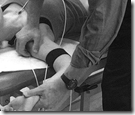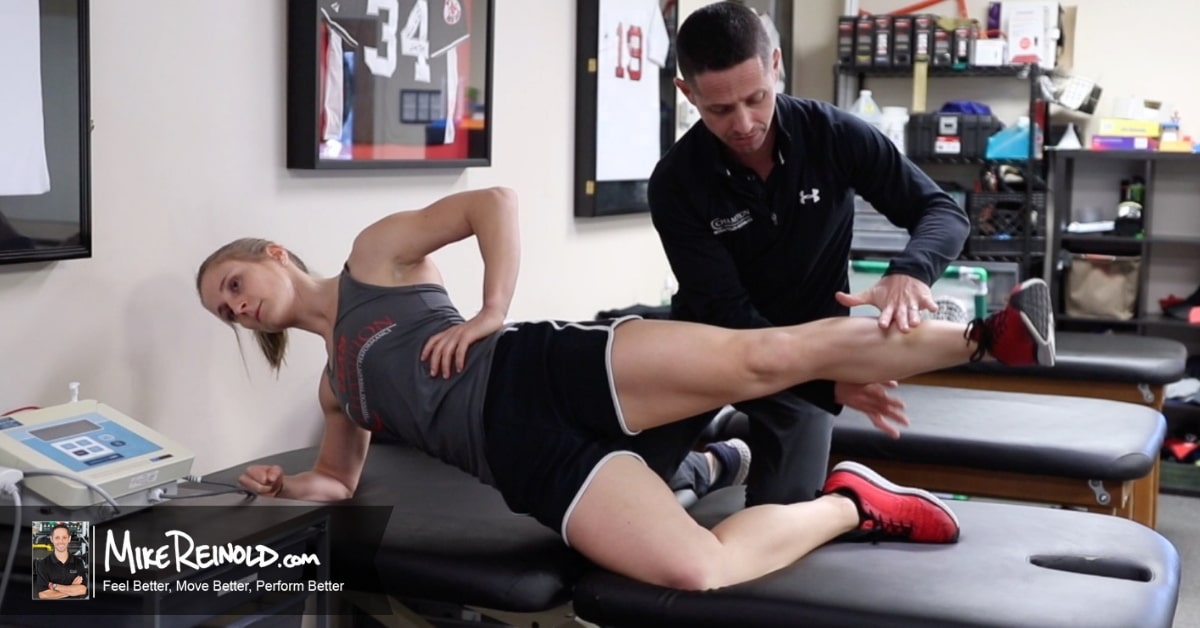
This post came about from some of the live Q&A that we had following my webinar last week on “assessing asymmetry in the overhead athlete – does asymmetry mean pathology?” (the webinar is now recorded and available for download if you couldn’t make the live session). We discussed some asymmetries with the scapula and talked about stretching the pectoralis minor. I thought this would be a good topic to post on for everyone to discuss.
The Effect of a Tight Pec Minor
There are a lot of theorized negative effects of a tight pec minor, mostly related to the position of the scapula:
- The scapula in people with a short pec minor has been shown to remain anteriorly tipped during arm elevation.
- The distance between the acromion and the humeral head has been shown to be reduced in both patients with shoulder pain and rotator cuff tears during arm movements.
- Studies have demonstrated that individuals with subacromial impingement have altered scapular kinematics, such as loss of posterior tipping and increased internal rotation
- It has been shown that after stretching the pec minor, the scapula kinematics of subjects are improved with a greater amount of scapular posterior tilt and external rotation.
The Best Stretch for the Pectoralis Minor?
As our knowledge has increased of the importance of posture and scapular position in normal shoulder function, the need to adequately lengthen the pectoralis minor becomes apparent. Any restrictions in pec minor length will pull the scapula into a protracted and anterior tilted position, which has been shown to inhibit strength of the lower trapezius and decrease the width of the subacromial space.
A problem exists, however. Many, if not all, of the standard stretches for the pectoralis minor place a decent amount of strain on the anterior capsule. This is typically something that many patient populations would want to avoid. We discussed some stretches for the pec minor in the past, but I wanted to talk about this again now that a year has past.
UPDATE: The results of the effectiveness of stretching the pec minor vary in the literature, some showing changes in pec minor length (PMI?) and scapular kinematics. I can’t help to think that the difference in outcomes are realted to the methodolgy of the stretching in the study. Some of showed very simple gross posture stretching. You could argue that the positive results are related to more effective stretching. SO, rather than say “stretching the pec minor” doesn’t help, it’s important to understand…
What does the evidence show?
There is some evidence behind stretching. A study by Borstad in JSES in 2006 compared three different techniques of stretching and found that they all produced changes in muscle length, but that the doorway stretch was superior:
- The doorway stretch = +2.24 cm
- A manual stretch in the sitting position = +0.77 cm
- A supine manual stretch = +1.7 cm





Not a bad start in terms of efficacy but I wish there were more stretches involved in the study.
Home Stretch for the Pectoralis Minor



Manual Stretching the Pectoralis Minor
I think we can do better using manual stretching in addition to the postural exercises I recommend above for at home. To stretch the pec minor, I have settled on a manual supine technique the combines aligning the shoulder in the correction orientation of the pectoralis minor muscle fibers and stabilizing the muscle by the coracoid. Notice I said stabilizing the muscle. I place a broad four finger grip deep into the pec minor just off from the coracoid. But it is important to note that I do this with the arm/pec in a loose position. You need to think of it as stabilizing, or “pinning” as I call it, the pec minor down. What you’ll find is that you will obtain a stretch in the pec (not the anterior shoulder) and you wont be able to bring the arm far down past the plane of the table.
Pin the muscle down with the arm loose:

And then bring the arm down:

Notice in these two photos below that by just adding this “pinning” of the pec minor I completely change stretch and take the strain of the anterior shoulder. In this position it is also pretty easy to utilize some MET and ART techniques as well, both of which I have found effective. The perspective is a bit hard to tell from the angle, but note that on the pinning stretch, the arm is about even with the table (perpendicular to the ground) to just barely past the table, without the pinning it dips about 20 degrees past the table:


You’ll know if you are doing this stretch right but asking the person what they feel – nice stretch in the pec versus a stretch in anterior shoulder. Sometimes they’ll even experience a tingle down their arm or in their hand, which is an obvious sign you are stretching too much of the anterior shoulder. I should also mention, it takes 2-3 sessions for the patient to get used to this stretch as you finger tips in this area are not always comfortable. Resist the urge to broaden you contact spot and use the palm of your hand etc, it never works as well.
So what do you think? Have you tried any of these stretches? Anything else I missed?
Pec Minor Photo: Wikipedia
Borstad, J., & Ludewig, P. (2006). Comparison of three stretches for the pectoralis minor muscle Journal of Shoulder and Elbow Surgery, 15 (3), 324-330 DOI: 10.1016/j.jse.2005.08.011




